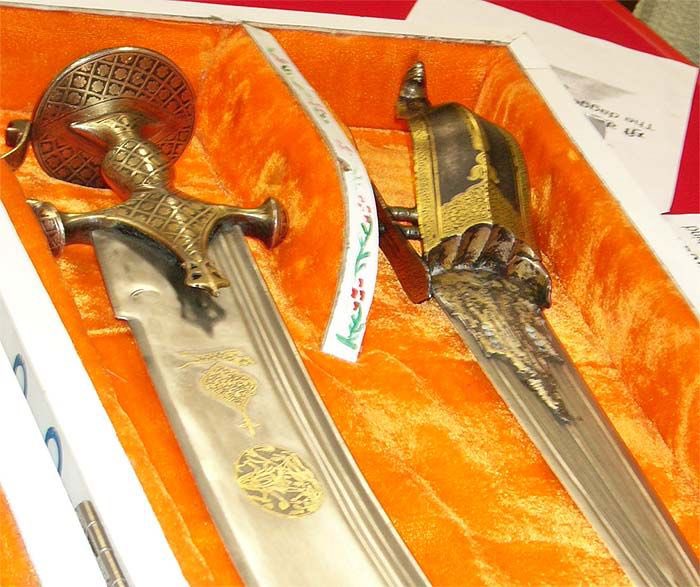
Author- 5 books (Babur: The Quest for Hindustan, Babur: The Chessboard King,The Proclaimed Messiah of the Palestinian Cause) || Urban-Designer & Architect II
198 subscribers
How to get URL link on X (Twitter) App





 2/4 Let’s now dig deeper into one of the strangest details in the Taj Mahal’s history, the story of a leaking Taj Mahal.
2/4 Let’s now dig deeper into one of the strangest details in the Taj Mahal’s history, the story of a leaking Taj Mahal.






 2/23 Prologue
2/23 Prologue

 What makes “The Protocols” such an undying cockroach in the sewer of conspiracy theories?
What makes “The Protocols” such an undying cockroach in the sewer of conspiracy theories?

 2/7 “History Written in Blood, Silence Etched in Stone”
2/7 “History Written in Blood, Silence Etched in Stone”

https://twitter.com/rons1212/status/1712971712542003595
 One of the earliest archaeological evidence of Durga Pujo comes as inscription in Dadhimati Mata Mandir which is located between the villages of Goth and Manglod in the Jayal tehsil of Nagaur district in Rajasthan, India.
One of the earliest archaeological evidence of Durga Pujo comes as inscription in Dadhimati Mata Mandir which is located between the villages of Goth and Manglod in the Jayal tehsil of Nagaur district in Rajasthan, India. 

 2) Maulana Azad Sobhani said in 1939:
2) Maulana Azad Sobhani said in 1939:
https://twitter.com/quizzicalguy/status/1702388451621085604In the same period when Athenian Democracy saw females as barbarians, Queen Mṛgāvatī of the Vatsa Mahajanapada ( oligarchic republics) ruled as proxy while her son Udayana was held captive by a rival king. And she was very well respected in society.

https://twitter.com/udhaystalin/status/1698012167994589221
 When the leaders of church demanded “freedom of religion” under the constitution, the Bolsheviks didn’t shy off to act. They executed 28 bishops and 6,775 priests.
When the leaders of church demanded “freedom of religion” under the constitution, the Bolsheviks didn’t shy off to act. They executed 28 bishops and 6,775 priests.
 Interestingly although the step of Maharaja was pro Meos, none except that of Alwar cooperated with the commission.
Interestingly although the step of Maharaja was pro Meos, none except that of Alwar cooperated with the commission. 
https://twitter.com/profdilipmandal/status/1684822905451163648When the first edition of “Hindu Temples: What happened to them? Vol-2” came, SR Goel sent a copy of book with letter to Prof Romila Thapar on June 27, 1991, where the above mentioned questions were directed.

 Infidel standards dominated some 200 towns in the territories of Islām; in them mosques and shrines fell into ruin; from them the wives and children of the Faithful were carried away captive. So greatly had his forces grown that, according to the Hindū calculation by which one… twitter.com/i/web/status/1…
Infidel standards dominated some 200 towns in the territories of Islām; in them mosques and shrines fell into ruin; from them the wives and children of the Faithful were carried away captive. So greatly had his forces grown that, according to the Hindū calculation by which one… twitter.com/i/web/status/1…

 Here @MichaelACT123 are actual versions of Al-Beruni’s map showing India (Hind)
Here @MichaelACT123 are actual versions of Al-Beruni’s map showing India (Hind)


 2/n In the above tweet, we have already established that largely Tipu’s policies were highly motivated by works & mission of Shāh Walīullāh Dehlavi (Deoband School of thought follows him too which is followed by Taliban) who was firm advocate for Ibn Taymiyya, and one of the… twitter.com/i/web/status/1…
2/n In the above tweet, we have already established that largely Tipu’s policies were highly motivated by works & mission of Shāh Walīullāh Dehlavi (Deoband School of thought follows him too which is followed by Taliban) who was firm advocate for Ibn Taymiyya, and one of the… twitter.com/i/web/status/1…


 Many won’t get what is so exciting for me.
Many won’t get what is so exciting for me. 



 But is this all? In fact idol worship became prohibited only with the coming of Singh Sabha. The Murtis were removed from the Harimandir (what we call golden temple today) only in 1905.
But is this all? In fact idol worship became prohibited only with the coming of Singh Sabha. The Murtis were removed from the Harimandir (what we call golden temple today) only in 1905. 
https://twitter.com/lokeshbag67/status/1638136596171223040Ambedkar spent his time only abusing Hindu Shastras, setting wrong precedent by burning Manusmriti, while Savarkar could bring real change by his project of braking seven shackles & bringing all together.